1994 CHEVROLET BLAZER four wheel drive
[x] Cancel search: four wheel drivePage 86 of 348

Downloaded from www.Manualslib.com manuals search engine An indicator light near
the lever shows you
the transfer case
settings:
2 WHEEL
4HIGH
0 N SET PARKING BRAKE
0 4LOW
The front axle portion of the diagram on the indicator will light up when
you shift into four-wheel drive.
A slight delay between shifting and the
pattern's lighting
is normal. If the pattern does not light up, or if the front
axle does not go out after you shift out of four-wheel drive, have your
dealer check your system. Turn the
LIGHTS switch located above your
headlight switch
to the left to dim your transfer case indicator light when
your headlights or parking lights are on.
2 WHEEL: This setting is for driving in most street and highway situations.
Your front axle
is not engaged in two-wheel drive.
4 HIGH: This setting engages your front axle to help drive your vehicle.
Use 4 HIGH when you need extra traction, such as on snowy or icy roads,
or
in most off-road situations.
N SET PARKING BRAKE: Shift to this neutral setting only when your
vehicle needs to be towed.
4 LOW This setting also engages your front axle to give you extra traction.
You may never need
4 LOW. It sends the maximum power to all four
wheels. You might choose
4 LOW if you were driving off-road in sand,
mud, or deep snow and climbing or descending steep hills.
You can shift from 2 WHEEL to 4 HIGH or from 4 HIGH to 2 WHEEL
while the vehicle is moving. It is not necessary for you to press the transfer
case shift lever button. Your front axle will engage faster if you take your
foot off of the accelerator for a few seconds after you shift.
2-32
Page 87 of 348

Downloaded from www.Manualslib.com manuals search engine To shift your transfer case into N SET PARKING BRAKE:
1. Stop the vehicle and shift your transmission into “N” (Neutral).
2. Set the parking brake. Your vehicle can roll unless the brakes are
applied.
To shift into or out of 4 LOW :
1. Allow your vehicle to roll at one-to-two mph or stop your vehicle and
shift your transmission into
“N” (Neutral).
2. Press the transfer case shift button and shift in one continuous motion.
Don’t pause in
N SET PARKING BRAKE as you shift into or out of 4
LOW, or your gears could clash.
Kemember that driving in
4 HIGH or 4 LOW may reduce fuel economy.
Also, driving in four-wheel drive on dry pavement could cause your tires to
wear faster and make
your transfer case harder to shift.
Electronic Transfer Case
If your four-wheel drive vehicle has the electronic transfer case, the transfer
case switch is on the left side of your instrument panel above the light
switches. Use this switch to shift into and out
of four-wheel drive. You can
choose among three driving settings:
1. Two-wheel drive, (2 WHEEL): This setting is for driving in most
street and highway situations. Your front axle is not engaged in
two-wheel drive.
2. 4 HI: This setting engages your front axle to help drive your vehicle.
Use
4 HI when you need extra traction, such as on snowy or icy roads,
or in most off-road situations.
2-33
Page 88 of 348
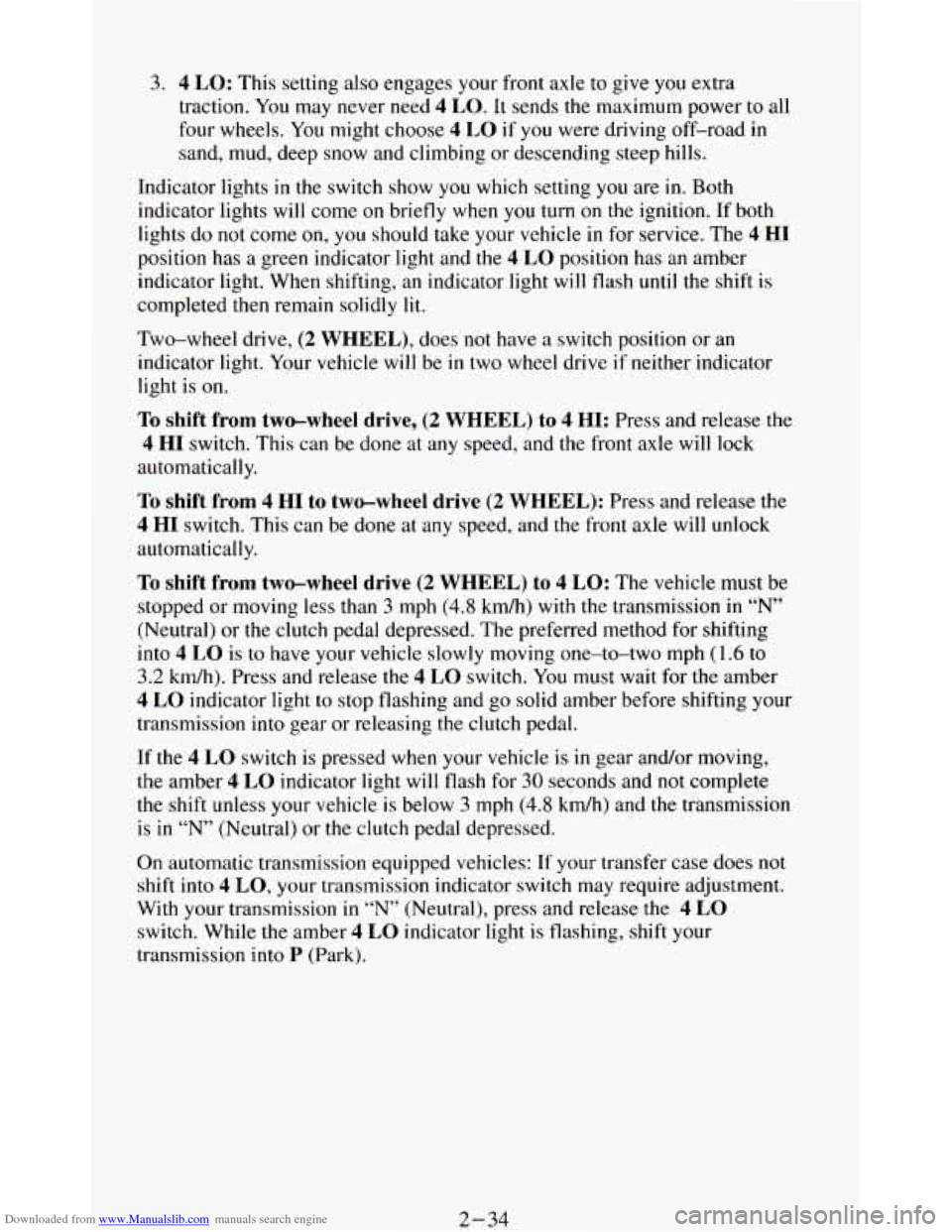
Downloaded from www.Manualslib.com manuals search engine 3. 4 LO: This setting also engages your front axle to give you extra
traction. You may never need
4 LO. It sends the maximum power to all
four wheels.
You might choose 4 LO if you were driving off-road in
sand, mud, deep snow and climbing or descending steep hills.
Indicator lights
in the switch show you which setting you are in. Both
indicator lights will come on briefly when
you turn on the ignition. If both
lights do
not come on, you should take your vehicle in for service. The 4 HI
position has a green indicator light and the 4 LO position has an amber
indicator light. When shifting, an indicator light will flash
until the shift is
completed then remain solidly lit.
Two-wheel drive, (2 WHEEL), does not have a switch position or an
indicator light. Your vehicle will be
in two wheel drive if neither indicator
light is
on.
To shift from two-wheel drive, (2 WHEEL) to 4 HI: Press and release the
4 HI switch. This can be done at any speed, and the front axle will lock
automatically.
To shift from 4 HI to two-wheel drive (2 WHEEL): Press and release the
4 HI switch. This can be done at any speed, and the front axle will unlock
automatically.
To shift from two-wheel drive (2 WHEEL) to 4 LO: The vehicle must be
stopped or moving less than
3 mph (4.8 km/h) with the transmission in “N’
(Neutral) or the clutch pedal depressed. The preferred method for shifting
into
4 LO is to have your vehicle slowly moving one-to-two mph (1.6 to
3.2 kdh). Press and release the 4 LO switch. You must wait for the amber
4 LO indicator light to stop flashing and go solid amber before shifting your
transmission
into gear or releasing the clutch pedal.
If the
4 LO switch is pressed when your vehicle is in gear and/or moving,
the amber
4 LO indicator light will flash for 30 seconds and not complete
the shift unless your vehicle is below
3 mph (4.8 kdh) and the transmission
is in
“N” (Neutral) or the clutch pedal depressed.
On automatic transmission equipped vehicles: If your transfer case does not
shift into
4 LO, your transmission indicator switch may require adjustment.
With your transmission in
“N” (Neutral), press and release the 4 LO
switch. While the amber 4 LO indicator light is flashing, shift your
transmission into
P (Park).
2-34
Page 119 of 348
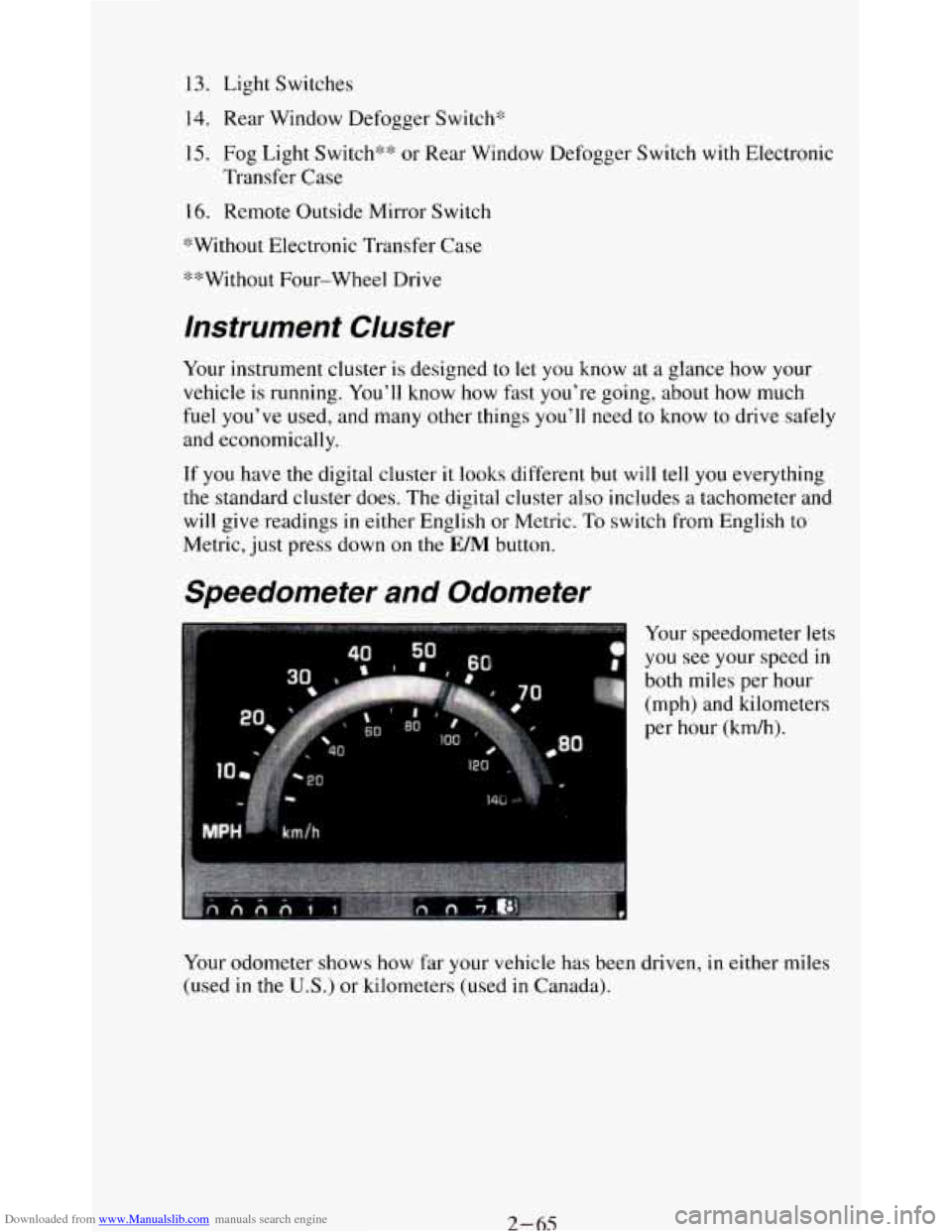
Downloaded from www.Manualslib.com manuals search engine 13. Light Switches
14. Rear Window Defogger Switch*
15. Fog Light Switch** or Rear Window Defogger Switch with Electronic
16. Remote Outside Mirror Switch
*Without Electronic Transfer Case
“*Without Four-wheel Drive
Transfer
Case
Instrument Cluster
Your instrument cluster is designed to let you know at a glance how your
vehicle is running. You’ll know how
fast you’re going, about how much
fuel you’ve used, and many other things
you’ll need to know to drive safely
and economically.
If you have the digital cluster it looks different but will tell you everything
the standard cluster does. The digital cluster
also includes a tachometer and
will give readings
in either English or Metric. To switch from English to
Metric, just press down on the E/M button.
Speedometer and Odometer
#3
Your speedometer lets
you see your speed
in
both miles per hour
(mph) and kilometers
per hour (kdh).
Y
Your odometer shows how far your vehicle has been driven, in either miles
(used in the
U.S.) or kilometers (used in Canada).
2-65
Page 159 of 348

Downloaded from www.Manualslib.com manuals search engine Your Driving and the Road
Section
Here you'll find information about driving on different kinds of roads and in
varying weather conditions . We've also included many other useful tips on
driving
.
Defensive Driving ..................... ................. 4-2
DrunkenDriving ........................................... 4-2
Braking ................................................ 4-5
Steering Tips ............................................ 4-8
Control
of a Vehicle
Steering
................................................ 4-8
Passing
............................................... 4-10
Loss of Control ......................................... 4-11
Driving Guidelines
......................................... 4-12
Off-Road Driving With Your Four-wheel Vehicle
............... 4-13
DrivingatNight ........................................... 4-24
Driving
in the Rain ........................................ 4-25
Freeway Driving
........................................... 4-8
Hill and Mountain Roads
.................................... 4-30
Winter Driving
............................................ 4-32
CityDriving
.............................................. 4-27
Recreational Vehicle Towing (Four-wheel Drive Only)
........... 4-35
TowingaTrailer
........................................... 4-37
4-1
Page 171 of 348
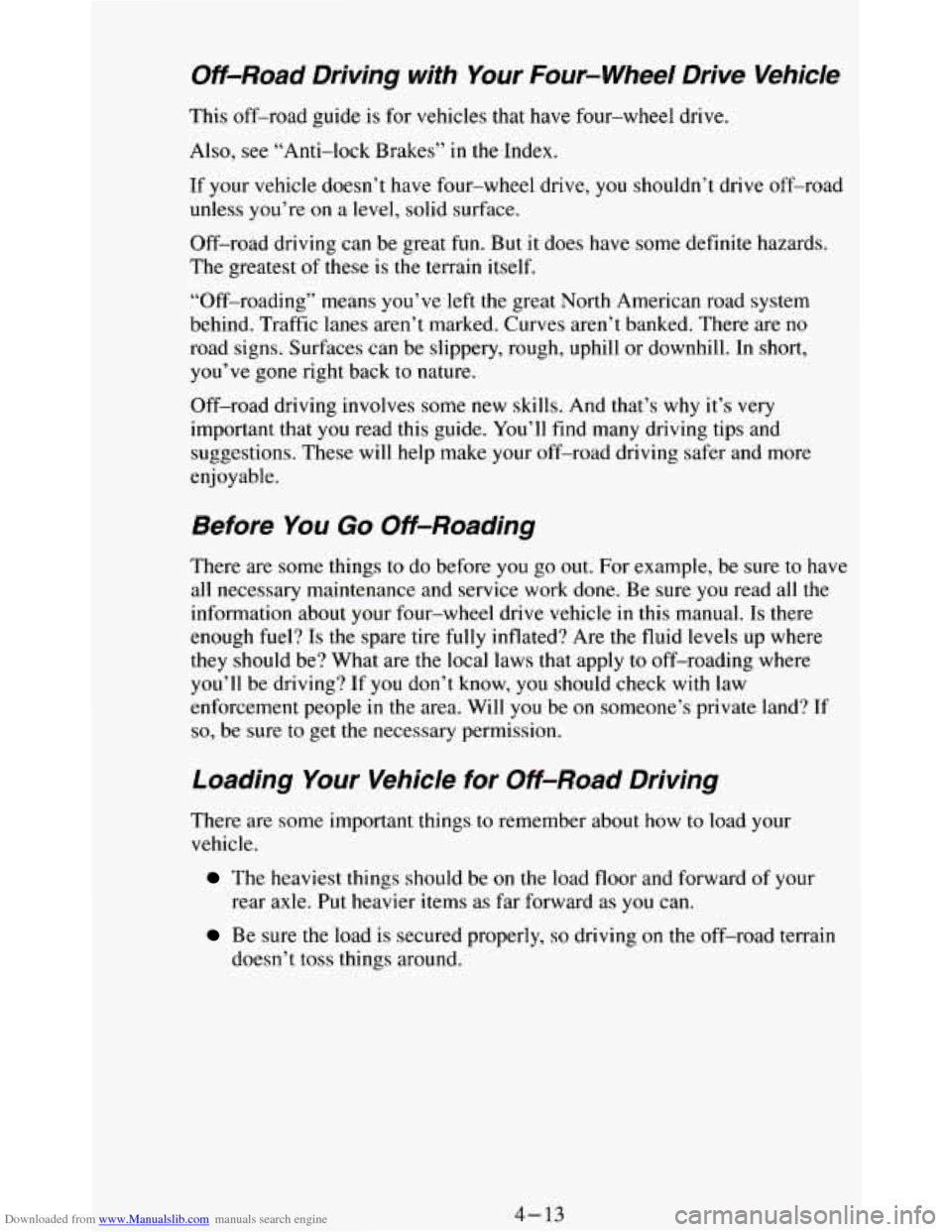
Downloaded from www.Manualslib.com manuals search engine Off-Road Driving with Your Four-wheel Drive Vehicle
This off-road guide is for vehicles that have four-wheel drive.
Also, see “Anti-lock Brakes”
in the Index.
If your vehicle doesn’t have four-wheel drive,
you shouldn’t drive off-road
unless you’re on a level, solid surface.
Off-road driving can be great
fun. But it does have some definite hazards.
The greatest
of these is the terrain itself.
“Off-roading” means you’ve left the great North American road system
behind. Traffic lanes aren’t marked. Curves aren’t banked. There are no
road signs. Surfaces can be slippery, rough, uphill or downhill. In short,
you’ve gone right back to nature.
Off-road driving involves some new skills. And that’s
why it’s very
important that you read this guide. You’ll find many driving tips and
suggestions. These
will help make your off-road driving safer and more
enjoyable.
Before You Go Off-Roading
There are some things to do before you go out. For example, be sure to have
all necessary maintenance and service work done. Be sure you read all the
information about your four-wheel drive vehicle
in this manual. Is there
enough fuel? Is the spare tire
fully inflated? Are the fluid levels up where
they should be? What are the local
laws that apply to off-roading where
you’ll be driving? If you don’t know, you should check with law
enforcement people
in the area. Will you be on someone’s private land? If
so, be sure to get the necessary permission.
Loading Your Vehicle for Off-Road Driving
There are some important things to remember about how to load your
vehicle.
The heaviest things should be on the load floor and forward of your
rear axle. Put heavier items as far forward as you can.
Be sure the load is secured properly, so driving on the off-road terrain
doesn’t toss things around.
4-13
Page 193 of 348
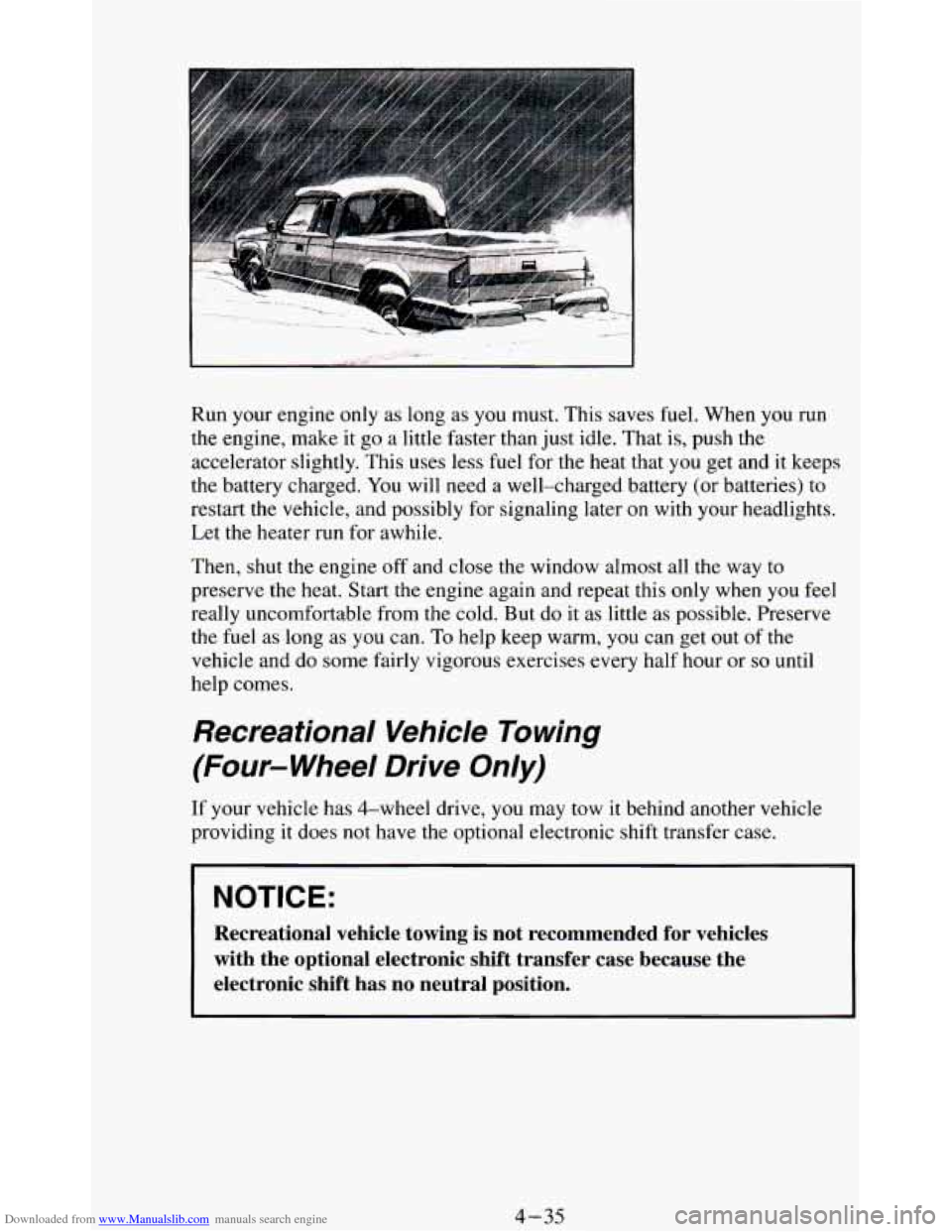
Downloaded from www.Manualslib.com manuals search engine Run your engine only as long as you must. This saves fuel. When you run
the engine, make it go a little faster than just idle. That is, push the
accelerator slightly. This uses less fuel for the heat that
you get and it keeps
the battery charged. You will need a well-charged battery (or batteries)
to
restart the vehicle, and possibly for signaling later on with your headlights.
Let the heater run for awhile.
Then, shut the engine
off and close the window almost all the way to
preserve the heat. Start the engine again and repeat this only when you feel
really uncomfortable from the cold. But
do it as little as possible. Preserve
the fuel as long as you can.
To help keep warm, you can get out of the
vehicle and do some fairly vigorous exercises every half hour or
so until
help comes.
Recreational Vehicle To wing
(Four-wheel Drive
Only)
If your vehicle has 4-wheel drive, you may tow it behind another vehicle
providing it does
not have the optional electronic shift transfer case.
Recreational vehicle towing is not recommended for vehicles
with the optional electronic shift transfer case because the
electronic shift has no neutral position.
4-35
Page 200 of 348
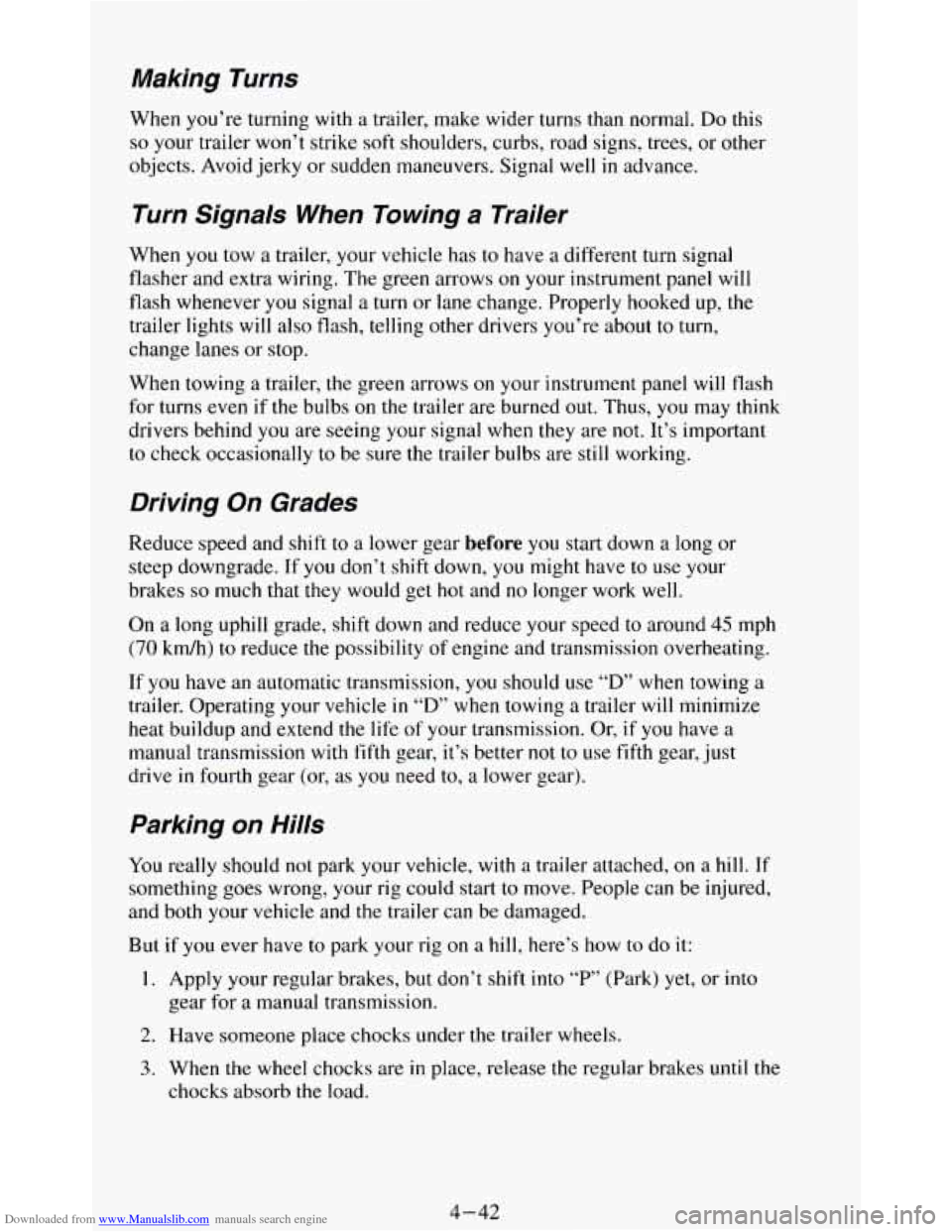
Downloaded from www.Manualslib.com manuals search engine Making Turns
When you’re turning with a trailer, make wider turns than normal. Do this
so your trailer won’t strike soft shoulders, curbs, road signs, trees, or other
objects. Avoid jerky or sudden maneuvers. Signal well
in advance.
Turn Signals When Towing a Trailer
When you tow a trailer, your vehicle has to have a different turn signal
flasher and extra wiring. The green arrows
on your instrument panel will
flash whenever you signal a turn or lane change. Properly hooked up, the
trailer lights will also flash, telling other drivers you’re about to turn,
change lanes or stop.
When towing a trailer, the green arrows
on your instrument panel will flash
for turns
even if the bulbs on the trailer are burned out. Thus, you may think
drivers behind you are seeing your signal when
they are not. It’s important
to check occasionally to be sure the trailer bulbs are still working.
Driving On Grades
Reduce speed and shift to a lower gear before you start down a long or
steep downgrade. If you don’t
shift down, you might have to use your
brakes
so much that they would get hot and no longer work well.
On a long uphill grade, shift down and reduce your speed
to around 45 mph
(70 kdh) to reduce the possibility of engine and transmission overheating.
If you have an automatic transmission,
you should use “D” when towing a
trailer. Operating your vehicle in “D” when towing a trailer will minimize
heat buildup and extend the
life of your transmission. Or, if you have a
manual transmission with
fifth gear, it’s better not to use fifth gear, just
drive in fourth gear (or, as
you need to, a lower gear).
Parking on Hills
You really should not park your vehicle, with a trailer attached, on a hill. If
something goes wrong, your rig could start to move. People can be injured,
and both your vehicle and the trailer can be damaged.
But if you ever have
to park your rig on a hill, here’s how to do it:
1. Apply your regular brakes, but don’t shift into “P” (Park) yet, or into
gear for a manual transmission.
2. Have someone place chocks under the trailer wheels.
3. When the wheel chocks are in place, release the regular brakes until the
chocks absorb
the load.
4-42